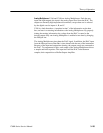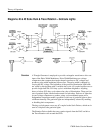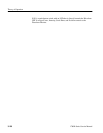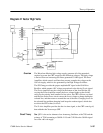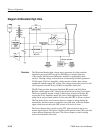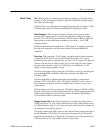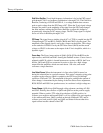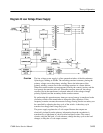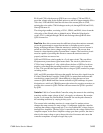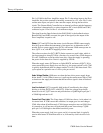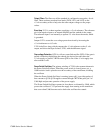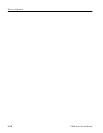
Theory of Operation
1780R-Series Service Manual
3–111
Osc. Q300 is the active element of an Armstrong Oscillator, with C410 and the
primary of T210 resonating at 25 kHz. L200 and C100 filter the 25-kHz signal
out of the +60 volt supply.
C500 provides a low impedance current path for the base drive winding of T250.
C300 prevents parasitic oscillations and R300 limits Q300 base current.
Power Supplies. U220 is a potted assembly of diodes and capacitors which
provides a DC output equal to four times the peak input voltage. The output
provides +15.6 kV DC post acceleration to the CRT anode. CR220 rectifies the
minus peaks from the transformer secondary to provide the –3.9 kV CRT
cathode potential.
CR500 rectifies the positive peaks from a T250 (pin 6 & 7) winding to provide
the+160 volts that powers the Waveform Monitor Horizontal Deflection
Amplifier.
Error Amp. U540 senses the –3.9 kV supply voltage through a resistor assembly
contained in R330. R330 is a four-section, thick-film resistor. Two closely
matched resistors form a voltage divider off of the –3.9 kV supply. The other two
resistors form the Focus voltage divider. The +5 volts supply provides current
into the resistive divider to bias pin 2 of R330 at 0 volts when the –3.9 kV
supply is at the proper operating voltage.
The Error Amp output varies to keep pin 2 of R330 at 0 volts, by controlling the
current through R501 and R500 to adjust base current for the High Volts
Oscillator, Q300.
The Error Amplifier is stabilized through several frequency compensation
elements: C243, C430, R531, C534, C533, R540, and R441. If one or more of
these elements is defective, the Error Amplifier may oscillate, or have a poor
response time.
Q530 provides a slow start on power-up. C530 pulls the base of Q530 low. When
the base of Q530 goes low, the emitter pulls down on CR520 to prevent the Error
Amp from providing base current to the oscillator. Eventually, R530 charges
C530 and the oscillator is allowed to start.
Voltage, Current Limit. If the 160 volt supply gets too high, the reference pin on
VR210 rises above 2.5 volts, which causes current to flow in the cathode circuit
of VR210 and turns on Q111. Q111 turns on Q110, which shuts the oscillator off
by shunting its base signal to ground.
The anode current in the CRT is equal to the current flowing in the ground pin of
the 4X Multiplier, U220. R320 is a current sense that turns on Q413 when the
anode current reaches 60 uA. When Q413 is turned on, the voltage reference for
VR210 rises above 2.5 volts and the oscillator is shut down.
Circuit Theory



